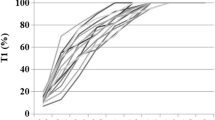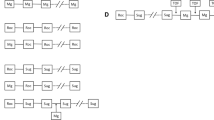Abstract
Purpose
The aim of this study was to examine the effect of landiolol hydrochloride, an ultrashort-acting β1-blocker, on suxamethonium-induced neuromuscular block.
Methods
Thirty patients were randomly allocated to receive a loading dose of landiolol, 0.125 mg·kg−1·min−1 for 1 min, followed by an infusion at 0.04 mg·kg−1·min−1, or placebo. Twenty minutes after the infusion of landiolol or placebo, suxamethonium 1 mg·kg−1 was administered during propofolfentanyl-nitrous oxide anesthesia. Neuromuscular block was monitored by train-of-four (TOF) responses of the adductor pollicis muscle, applying acceleromyographic stimuli to the ulnar nerve.
Results
The onset of neuromuscular block did not differ between the groups. The time from administration of suxamethonium to spontaneous recovery to the first twitch of TOF (T1) of control was significantly longer in the landiolol group (mean [SD]; 12.2 [2.5] min), when compared with the control group (9.8 [2.6] min). However, the TOF ratios measured when the T1 had spontaneously recovered to 10%, 25%, 50%, 75%, 90%, and 100% of control was comparable between the groups.
Conclusion
Landiolol delayed recovery from suxamethonium-induced paralysis. However, the interaction between the drugs seemed to be small in the clinical setting.
Similar content being viewed by others
References
Mangano DT, Layug EL, Wallace A, Tateo I. Effect of atenolol on mortality and cardiovascular morbidity after noncardiac surgery. Multicenter study of Perioperative Ischemia Research Group. N Engl J Med. 1996;335:1713–1720.
Auerbach AD, Goldman L. β-Blockers and reduction of cardiac events in noncardiac surgery: scientific review. JAMA. 2002;287:1435–1444.
Safwat AM, Fung DL, Bilton DC. The use of propranolol in rapid sequence anaesthetic induction: optimal time interval for pretreatment. Can Anaesth Soc J. 1984;31:638–641.
Chia YY, Chan MH, Ko NH, Liu K. Role of beta-blockade in anaesthesia and postoperative pain management after hysterectomy. Br J Anaesth. 2004;93:799–805.
Vucevic M, Purdy GM, Ellis FR. Esmolol hydrochloride for management of the cardiovascular stress responses to laryngoscopy and tracheal intubation. Br J Anaesth. 1992;68:529–530.
Goyagi T, Tanaka M, Nishikawa T. Landiolol attenuates the cardiovascular response to tracheal intubation. J Anesth. 2005;19:282–286.
Kawaguchi M, Takamatsu I, Masui K, Kazama T. Effect of landiolol on bispectral index and spectral entropy responses to tracheal intubation during propofol anaesthesia. Br J Anaesth. 2008;101:273–278.
Yamazaki A, Kinoshita H, Shimogai M, Fujii K, Nakahata K, Hironaka Y, Iranami H, Hatano Y. Landiolol attenuates tachycardia in response to endotracheal intubation without affecting blood pressure. Can J Anaesth. 2005;52:254–257.
Atarashi H, Kuruma A, Yashima M, Satoh H, Ino T, Endoh Y, Hayakawa H. Pharmacokinetics of landiolol hydrochloride, a new ultra-short-acting β-blocker, in patients with cardiac arrythmias. Clin Pharmacol Ther. 2000;68:143–150.
Vanlinthout LE, van Egmond J, de Boo T, Lerou JG, Wevers RA, Booji LH. Factors affecting magnitude and time course of neuromuscular block produced by suxamethonium. Br J Anaesth. 1992;69:29–35.
Wislicki L, Rosenblum I. Effects of propranolol on the action of neuromuscular blocking drugs. Br J Anaesth. 1967;39:939–942.
Morales-Aguilera A, Vaughan Williams EM. The effects on cardiac muscle of β-receptor antagonists in relation to their activity as local anesthetics. Br J Pharmacol. 1965;24:332–338.
Usubiaga JE. Neuromuscular effects of beta-adrenergic blockers and their interaction with skeletal muscle relaxants. Anesthesiology. 1968;29:484–492.
Iguchi S, Iwamura H, Nishizaki M, Hayashi A, Senokuchi K, Kobayashi K, Sakaki K, Hachiya K, Ichioka Y, Kawamura M. Development of a high cardioselective ultra short-acting β-blocker, ONO-1101. Chem Pharmacol Bull. 1992;40:1462–1469.
Vizi ES. Evidence that catecholamines increase acetylcholine release from neuromuscular junction through stimulation of alpha-1 adrenoreceptors. Naunyn-Schmiedeberg’s Arch Pharmacol. 1991;343:435–438.
Drury PJ, Birmingham AT, Healy TEJ. Interaction of adrenaline with neostigmine and tubocurarine at the skeletal neuromuscular junction. Br J Anaesth. 1987;59:784–790.
Murthy VS, Patel KD, Elangovan RG, Hwang TF, Solochek SM, Steck JD, Laddu AR. Cardiovascular and neuromuscular effects of esmolol during induction of anesthesia. J Clin Pharmacol. 1986;26:351–357.
Suzuki H, Yazaki S, Kanayama T, Nakagawa H, Ogawa S, Kuniyoshi K, Tai K. Neuromuscular effects of i.a. infusion of lignocaine in man. Br J Anaesth. 1977;49:1117–1122.
Schreiber JU, Lysakowski C, Fuchs-Buder T, Tramèr MR. Prevention of succinylcholine-induced fasciculation and myalgia: a meta-analysis of randomized trials. Anesthesiology. 2005;103:877–884.
Suzuki T, Mizutani H, Ishikawa K, Miyake E, Saeki S, Ogawa S. Epidurally administered mepivacaine delays recovery of train-offour ratio from vecuronium-induced neuromuscular block. Br J Anaesth. 2007;99:721–725.
Akimoto A, Kitagawa T, Kamanaka Y, Yanagisawa Y, Komeno M, Yanagi H, Kasahara T, Sakamoto T, Nitta H, Yanase R, Fujita T. General pharmacological studies of landiolol hydrochloride (ONO-1101) (in Japanese). Oyo Yakuri (Pharmacometrics). 1997;54:53–67.
Ezri T, Szmuk P, Waters RD, Gebhard RE, Pivalizza EG, Katz J. Changes in onset time of rocuronium in patients pretreated with ephedrine and esmolol–the role of cardiac output. Acta Anaesthesiol Scand. 2003;47:1067–1072.
Goto K, Shingu C, Miyamoto S, Miyakawa H, Noguchi T. The effect of landiolol on hemodynamics and left ventricular function in patients with coronary artery disease. J Clin Anesth. 2007;19:523–529.
Nigrovic V, McCullough LS, Wajskol A, Levin JA, Martin JT. Succinylcholine-induced increases in plasma catecholamine levels in humans. Anesth Analg. 1983;62:627–632.
Author information
Authors and Affiliations
About this article
Cite this article
Suzuki, T., Aono, M., Isaka, T. et al. Effect of landiolol hydrochloride on suxamethonium-induced neuromuscular block. J Anesth 23, 188–191 (2009). https://doi.org/10.1007/s00540-008-0727-y
Received:
Accepted:
Published:
Issue Date:
DOI: https://doi.org/10.1007/s00540-008-0727-y




